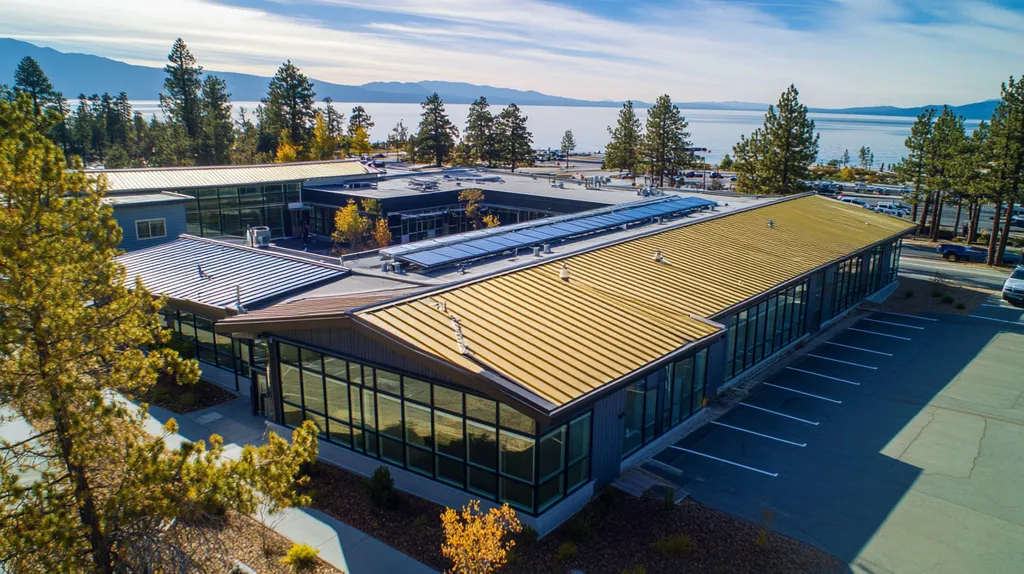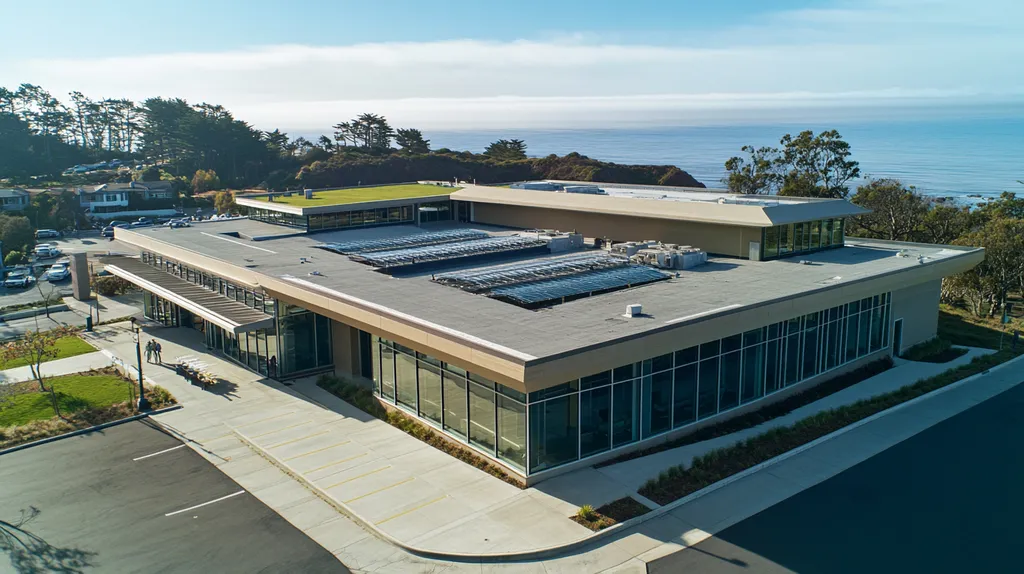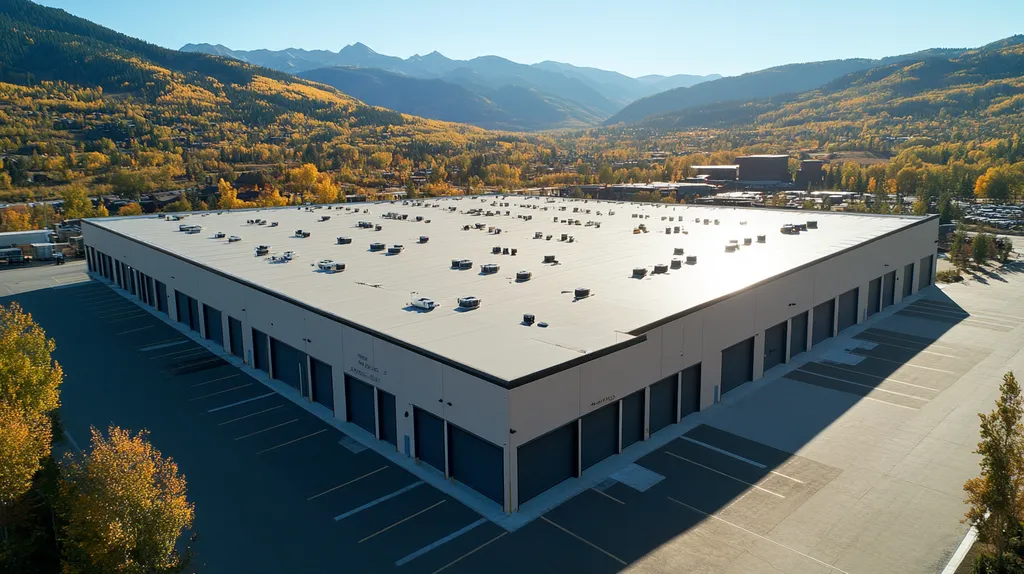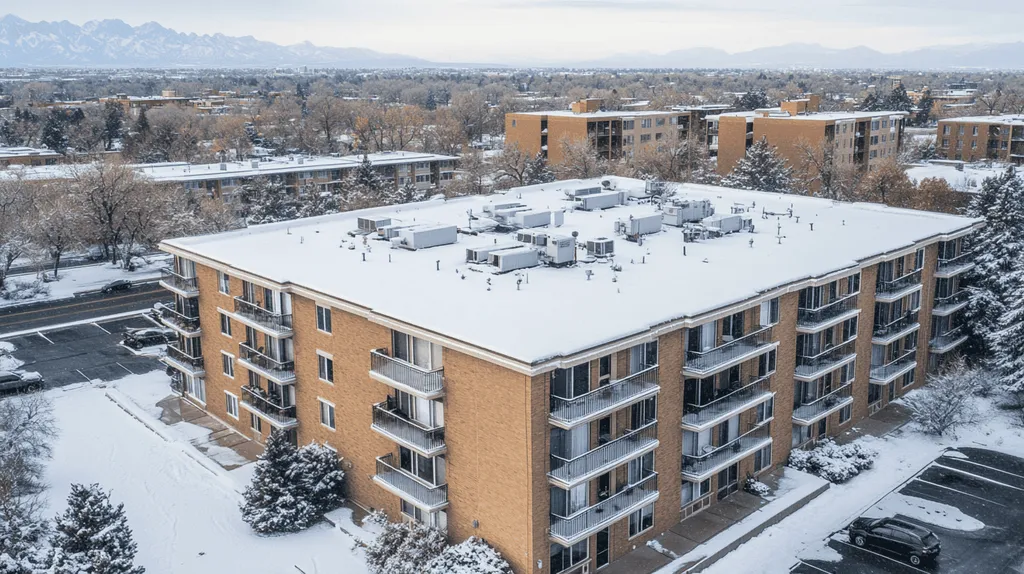Commercial roofing warranties represent a critical yet frequently misunderstood aspect of building asset protection, with studies showing that up to 70% of warranty claims are initially denied due to compliance issues.
For property owners and facility managers, navigating warranty terminology and requirements can mean the difference between comprehensive coverage and devastating financial exposure.
This article examines common warranty misconceptions, practical implications, and evidence-based strategies to help building owners make informed decisions about their roofing investments.
SECTION 1: COMMON MISCONCEPTIONS
Misunderstandings about commercial roofing can lead to significant financial setbacks. Alarmingly, around 30% of property owners may inadvertently put their assets at risk due to incorrect beliefs about roof warranties. This section tackles widespread misconceptions that can adversely affect the performance of a roof, including the idea that warranties cover all components, the mistaken belief that maintenance can be disregarded, and the notion that all warranties provide the same level of protection.
Warranty Covers All Roof Components
A prevalent myth is that roofing warranties include coverage for every part of a roof system. In fact, most warranties only protect specific elements, like the membrane or the installation itself. For instance, while a warranty may shield against leaks in the roofing membrane, it might not cover expenses related to critical accessories such as flashing or drainage systems.
This confusion can lead to unexpected repair costs. Property owners might assume they have complete protection, causing them to overlook the overall health of their roof system. When it’s time to file a claim, they may find themselves facing obstacles due to missing coverage.
Understanding the details of what a warranty includes is essential. Owners should carefully review the fine print and ask their roofing contractor to clarify any confusing language. This includes discussing exactly which components are covered to avoid future disputes.
To ensure comprehensive protection, owners should evaluate the entire roofing system and consider warranties that explicitly cover all components to prevent unforeseen expenses after installation.
Maintenance is Unnecessary with a Warranty
Another common misconception is that having a warranty means there is no need for regular roof maintenance. In truth, most warranties require property owners to perform ongoing maintenance to keep the warranty valid. Ignoring these maintenance requirements can void the warranty, leaving property owners vulnerable to hefty repair bills.
For example, many warranties require annual inspections and proactive repairs for minor issues. Skipping these inspections could jeopardize the warranty and lead to significant damage when unnoticed problems escalate over time.
Regular maintenance is critical for catching any potential issues early on. By establishing a routine maintenance plan, property owners can extend the lifespan of their roof and maintain their warranty coverage. This proactive strategy is vital for protecting an important investment.
Property owners need to discuss maintenance requirements with their roofing contractors. Recognizing these conditions and ensuring compliance can prevent future conflicts and financial losses due to uncovered damages.
All Warranties Offer the Same Protection
Many property owners mistakenly believe that all roofing warranties deliver the same level of protection. However, warranties can vary widely in coverage duration, material quality, and specific terms. For instance, a manufacturer’s warranty might differ significantly from a contractor’s labor warranty.
Choosing the correct warranty requires a thorough evaluation of its details. Warranties might differ in terms of coverage scope for repairs, maintenance, and replacement costs. Owners can easily make poor decisions if they assume that the name of a warranty guarantees quality or comprehensiveness.
This misunderstanding can lead to inadequate coverage, inadvertently compromising the building’s protection. Knowing the differences among warranties empowers owners to make informed decisions that meet their unique needs.
Investing time to research and compare warranty options can yield significant long-term benefits. Selecting a warranty tailored to the specific requirements of the roofing system is essential for ensuring robust protection and peace of mind.
SECTION 2: PRACTICAL IMPLICATIONS
The choices made regarding roofing warranties can have far-reaching effects on the longevity and performance of commercial roofs. Research indicates that inadequate warranty management can lead to premature roof failures, costing property owners thousands in unplanned repairs. For building owners and facility managers, grasping the implications of roofing warranties is vital for ensuring the durability and reliability of their roofing systems.
Impact on Roof Longevity and Performance
The type of warranty selected directly impacts a roof’s lifespan and functionality. Extended warranties from manufacturers often cover material defects, enhancing performance under specified conditions. Conversely, a shorter warranty might signal limited coverage, leaving owners at risk for significant repair costs should any issues surface.
Additionally, roofs covered by warranties are more likely to receive proper upkeep. Regular inspections and timely repairs can lead to extended lifespans—studies have shown that roofs with comprehensive warranties last an average of five years longer than those without.
It’s important for property owners to recognize the differences in warranty terms. Some warranties may cover only specific types of damage, while others might offer extensive protection. This understanding is critical for managing roofing costs and ensuring structural integrity over time.
A well-comprehended warranty not only alleviates concerns but also bolsters overall roof performance and lifespan, representing a sound investment for property owners.
Role of Regular Maintenance in Warranty Validity
Regular maintenance is essential for maintaining warranty validity, yet it is often overlooked by property owners. Many warranties stipulate that periodic inspections and maintenance must be performed to keep the warranty active. Failing to follow these requirements can void the warranty, leading to substantial out-of-pocket repair costs.
Manufacturers frequently provide guidance on necessary maintenance steps, including cleaning, inspections, and prompt repairs. Following these recommendations can prevent costly problems and prolong a roof’s effective life.
For example, if a roof develops a leak because of neglected maintenance and the owner lacks proof of routine inspections, the warranty may not cover necessary repairs. Such situations can result in financial burdens reaching tens of thousands, negatively impacting business profit margins.
By keeping detailed maintenance records and engaging in proactive upkeep, property owners can protect their investments and ensure that warranty coverage remains valid, thereby securing reliable roof performance for years to come.
Differences Between Material and Workmanship Warranties
Understanding the distinctions between material and workmanship warranties is vital for making informed roofing decisions. Material warranties cover defects in the roofing materials, while workmanship warranties focus on the quality of the installation process.
Material warranties typically guarantee that defects in the product will be repaired or replaced, often lasting between 10 and 30 years. However, if the installation is faulty, this warranty becomes ineffective, as poor craftsmanship can lead to premature failures that are not covered by material warranties.
Workmanship warranties, which generally range from 1 to 10 years, protect property owners from issues stemming from inadequate installation practices. Such warranties hold contractors accountable, providing recourse for owners if the roof fails due to installation errors.
Adopting a balanced strategy that incorporates both types of coverage offers property owners broader protection, ensuring they are safeguarded against unexpected costs linked to roofing failures.
SECTION 3: COST OF MISINFORMATION
Neglecting proper maintenance on a commercial roof can lead to serious financial consequences. Research indicates that approximately 70% of roofing failures result from inadequate upkeep. Building owners must grasp the ongoing costs stemming from misinformation, including unexpected repairs and the potential loss of warranty coverage.
Financial Consequences of Neglecting Maintenance
Neglecting a commercial roof can translate into significant expenses for property owners. Regular inspections and maintenance play a crucial role in preventing minor issues from escalating into costly repairs. For example, a small leak can quickly lead to widespread water damage and mold growth, dramatically raising repair bills.
In roofing, the rule of thumb is that proactive maintenance is far cheaper than reactive fixes. A routine maintenance call might cost a few hundred dollars, whereas repairing extensive damage due to neglect can reach tens of thousands. This discrepancy highlights the urgent need for a consistent maintenance schedule.
Additionally, neglect can create safety hazards, increasing liability risks. A roof collapse from inadequate maintenance can result in staggering financial repercussions, including legal costs and damages. Property owners should prioritize upkeep to ensure the long-term sustainability of their investment.
Beyond direct repair costs, operational disruptions due to roofing issues can also harm the financial health of a business. Closing for repairs leads to lost revenue, making comprehensive maintenance strategies critical for safeguarding profitability.
Unexpected Repair Costs Without Proper Coverage
Although commercial roofs generally come with warranties, neglecting maintenance can lead to those warranties being voided. If a roof fails due to poor upkeep, property owners may encounter unexpected repair expenses that are not covered, resulting in financial strain, especially if emergency repairs are necessary.
For instance, if a roofing system is not inspected annually as required by the warranty, undetected damage may accumulate, leading to extensive repair costs. A single oversight can snowball quickly, costing thousands that could have been avoided with simple maintenance.
Moreover, without the protective shield of a warranty, building owners bear the entire financial burden of repairs and replacements. This can disrupt budgets and negatively impact overall operations. Understanding warranty conditions is essential to avoid these financial shocks.
Many property owners underestimate the importance of routine maintenance, viewing it as an optional cost. However, neglecting warranty compliance can become one of the most expensive mistakes a property owner can make.
Loss of Warranty Due to Non-Compliance
Warranties for commercial roofs typically include detailed requirements for maintenance and compliance. These stipulations are designed to ensure the durability of the roofing system. Ignoring these requirements can lead to a complete loss of warranty coverage.
For example, if a warranty dictates annual inspections and an owner fails to adhere to this schedule, future claims may be denied. This can result in major financial losses when a failure occurs, leaving the owner fully responsible for the repair costs.
Understanding warranty terms is critical. Many warranties contain clauses that may seem insignificant but are pivotal regarding compliance. Building owners must carefully read and comprehend these documents to avoid unintentionally voiding their warranty protections.
Ultimately, maintaining compliance with warranty conditions is not merely a contractual obligation; it serves as a crucial financial safeguard. Informed property owners actively align their roof maintenance with warranty requirements to protect their investments effectively.
SECTION 4: REALITY CHECK
Grasping the nuances of roofing warranties is paramount for property owners and facility managers. Many mistakenly believe that warranties offer blanket protection; however, complexities abound. Research indicates that nearly 30% of roofing claims are denied due to misunderstandings regarding warranty language. This section will clarify what warranties truly cover, stress the importance of analyzing fine print, and outline the various types of commercial roof warranties available.
What Warranties Actually Cover and Exclude
Many property owners wrongly assume that their commercial roof warranty covers all potential issues. In reality, warranties often delineate specific damages that are included, such as material defects, while explicitly excluding damages caused by environmental factors or lack of maintenance.
For instance, a warranty may cover leaks arising from defective materials but exclude those resulting from ponding water due to improper drainage or negligent upkeep. This distinction can lead to unanticipated repair costs when the excluded issues arise.
Understanding these limitations is vital. Without clear awareness of what is and isn’t covered, property owners may find themselves facing hefty repair bills while erroneously relying on their warranties. Therefore, clarifying the scope of coverage is essential for informed decision-making.
Moreover, many warranties stipulate conditions that must be adhered to in order to maintain coverage. Failure to meet these requirements can render the warranty void, leaving property owners financially exposed in times of need.
Importance of Reading Fine Print and Conditions
The fine print of a warranty often conceals crucial exclusions and conditions. Many property owners overlook this critical aspect, focusing instead on the general assurances that a warranty seems to provide.
For example, some warranties may mandate regular maintenance checks performed by a licensed professional. Neglecting to adhere to this requirement could result in damage claims being denied. Additionally, misunderstandings regarding the lifespan of the warranty or claims filing procedures can arise from failing to read the fine print.
Vigilance in reviewing warranty language can avert future disputes. Consulting with a legal expert or roofing consultant can unravel these complexities, ensuring property owners are adequately informed.
Reading and comprehending the fine print empowers building owners to make wiser choices regarding their roofing systems while reinforcing the necessity of proactive maintenance to uphold warranty validity.
Types of Commercial Roof Warranties Available
Warranties for commercial roofs generally fall into two primary categories: material warranties and workmanship warranties. Each serves a distinct function and covers different aspects of the roofing system.
Material warranties cover roofing materials like membranes, insulation, and coatings. Typically lasting from 10 to 30 years, these warranties vary based on the manufacturer and specific materials involved.
Workmanship warranties, in contrast, cover the installation of the roofing system itself. Generally spanning from 1 to 10 years, these warranties protect against failures arising from poor installation practices.
Comprehending the nuances of each type is crucial for effective risk management. Some manufacturers offer combined warranties, blending elements of both, thereby providing broader protection.
Ultimately, property owners must assess their project’s unique requirements and risk exposure when selecting the appropriate roofing warranty. Aligning warranty choices with specific roofing conditions ensures better protection against unforeseen issues in the future.
SECTION 5: EVIDENCE-BASED ALTERNATIVES
Neglecting preventative maintenance for commercial roofs can lead to costly repairs and significant financial loss. Research indicates that proactive maintenance can extend a roof’s lifespan by up to 50%. Property owners and facility managers must recognize that effective strategies exist to uphold warranties and secure the longevity of their roofing systems. This section underscores the importance of implementing preventative maintenance schedules, selecting competent contractors, and diligently documenting all maintenance activities.
Benefits of Preventative Maintenance Schedules
Establishing a preventative maintenance schedule is crucial for maximizing the lifespan of a commercial roof. Regular inspections can uncover minor issues before they escalate into expensive repairs, ultimately saving money. Studies show that proactive maintenance can lower repair costs by as much as 30% compared to reactive strategies.
Such schedules promote strategic planning, enabling facility managers to allocate budget resources effectively. By adhering to a consistent maintenance routine, property owners can often avoid premature roof replacements. A well-functioning roof ultimately enhances property value and supports sustained occupancy rates.
Moreover, many manufacturers stipulate proof of maintenance when processing warranty claims. By establishing a routine, property owners can ensure compliance with these requirements, thus protecting their investment. Preventative maintenance not only boosts performance but also reinforces warranty validity.
With ongoing attention, issues like leaks or membrane failures can be addressed proactively. Hence, investing in a tailored maintenance plan is not merely an expense; it’s a strategic initiative aimed at ensuring both long-term savings and operational reliability.
Choosing the Right Contractor for Warranty Compliance
Selecting a qualified and reliable contractor is essential for meeting warranty requirements. A skilled contractor understands industry standards and adheres to the manufacturer’s installation guidelines. Failure to comply with these specifications can void warranties and lead to expensive repairs.
Property owners should carefully evaluate contractors by checking credentials and reviewing past customer feedback. Hiring professionals with proven expertise in commercial roofing helps guarantee that projects meet necessary standards. Additionally, utilizing contractors who specialize in roofing minimizes the risks of improper installation.
Choosing an unsuitable contractor can significantly impact warranty coverage. Even a small installation error can result in extensive damage and substantial financial burdens. Contractors knowledgeable about warranty requirements play a crucial role in maintaining eligibility for future claims.
By prioritizing qualifications over cost, facility managers can ensure roofs are both installed and maintained correctly. The right contractor becomes a valuable partner, not only in compliance but also in optimizing the roof’s overall performance.
Documenting Maintenance for Warranty Claims
Accurate documentation of all maintenance activities performed on a commercial roof is vital, especially when warranty claims are submitted. Keeping precise records of inspections and repairs demonstrates compliance with warranty terms. This documentation acts as a safeguard, providing evidence that property owners have fulfilled their responsibilities.
Facility managers should log service dates, types of maintenance performed, and materials utilized. This information can be essential in substantiating any claims, as it validates the owner’s ongoing commitment to roof maintenance. Without thorough records, owners may experience delays or rejections when filing warranty claims.
Establishing an efficient filing system can help streamline the documentation process. Utilizing digital tools for tracking enhances organization and accessibility. A transparent historical record of maintenance activities not only supports claims but also enables monitoring trends in roof performance over time.
In conclusion, comprehensive documentation assures manufacturers and service providers of a strong commitment to maintenance. The effectiveness of a warranty lies not solely in its coverage but also in the property owner’s ability to substantiate claims through diligent record-keeping.
SECTION 6: TEST AND VERIFY
In the commercial roofing sector, neglecting testing and verification can lead to serious and costly failures. Alarmingly, 70% of premature roof replacements occur due to inadequate inspections and non-compliance with warranty terms. Property owners must prioritize regular checks to safeguard investments and meet warranty obligations. This section outlines critical practices, including conducting systematic inspections, adhering to manufacturer specifications, and verifying warranty details.
Conducting Regular Inspections and Audits
Establishing a routine inspection schedule is essential for keeping a commercial roof in good condition. Industry standards recommend at least two inspections annually, with additional evaluations after severe weather events. These inspections are vital for spotting potential issues like leaks, pooling water, or membrane damage before they escalate into significant problems.
Documenting inspections provides crucial support for warranty claims. A roof consistently maintained through detailed audits is more likely to be defended against warranty disputes. Organizations that emphasize regular inspections tend to benefit from longer-lasting roofs and fewer emergency repair situations.
It’s advantageous for building owners to collaborate with experienced roofing professionals during inspections. These specialists can uncover hidden issues often overlooked by the untrained eye. A proactive approach to inspecting roofs not only saves time but can also prevent costly repairs down the line.
Maintaining vigilance through regular inspections extends the roof’s lifespan and optimizes performance throughout its expected lifecycle. In essence, these inspections reflect a commitment to responsible roof management.
Adhering to Manufacturer Specifications
Compliance with manufacturer specifications is crucial for ensuring maximum warranty coverage. Each roofing system has distinct guidelines regarding installation, maintenance, and acceptable materials. Deviating from these specifications can void warranties, leaving property owners liable for costly repairs.
For instance, using unapproved materials during repairs can compromise both the roof’s integrity and the warranty. It is imperative that building owners ensure that contractors are well-versed in these requirements and strictly adhere to them throughout any project.
Maintaining records of installation and materials used is equally important, as this documentation may be required for warranty claims. Reliable contractors will provide detailed records that help ensure compliance and facilitate any potential claims.
Selecting materials and methods that conform to manufacturer guidelines not only safeguards the roof but also sets the stage for a smoother warranty experience if issues arise.
Verifying Warranty Terms and Conditions
Understanding warranty terms and conditions is essential for effective roof management. Many property owners neglect to read the fine print, risking significant coverage gaps when warranty claims are needed. These warranties can differ widely, particularly regarding coverage duration and exclusions.
For example, certain warranties may cover damages but exclude those resulting from neglect or improper maintenance. Property owners must fully understand the scope of coverage to prevent unpleasant surprises later on. Consulting with roofing professionals can clarify complex warranty language in straightforward terms.
Additionally, performing regular reviews of warranty terms can reveal changes or updates that might affect coverage. Staying informed allows building owners to align their maintenance plans with warranty requirements, ensuring full protection.
Ultimately, a comprehensive understanding of warranty terms enables property owners to make informed decisions and create an effective maintenance strategy for their roofs.
The Bottom Line
With 70% of commercial roof warranty claims initially denied and premature failures costing businesses millions annually, the stakes for proper warranty management could not be higher.
Property owners who neglect to verify coverage details, maintain proper documentation, and follow manufacturer specifications risk devastating financial exposure.
The evidence clearly demonstrates that successful warranty management requires three critical elements: thorough understanding of coverage terms, strict adherence to maintenance schedules, and proper documentation of all roofing activities.
As commercial roofing systems become more complex and warranties more specific, facility managers must transition from reactive to proactive approaches in protecting their roofing investments.
The cost of misunderstanding or mismanaging warranties far exceeds the investment required for proper compliance and maintenance.
FREQUENTLY ASKED QUESTIONS
Q. Do commercial roof warranties cover all components?
A. No, warranties typically cover specific elements like membranes or installation, not all components. It’s essential to review the warranty details carefully to understand which parts are protected and avoid unexpected repair costs.
Q. Why is regular maintenance needed for industrial roofs?
A. Regular maintenance is often a requirement to keep the warranty valid. Without it, property owners risk voiding their warranty, which can lead to expensive repairs and potential roof failures.
Q. Do all commercial roof warranties provide the same protection?
A. No, warranties vary significantly in coverage terms, duration, and conditions. It’s crucial for property owners to evaluate the specific terms to ensure adequate protection for their unique roofing needs.
Q. What are the financial consequences of neglecting commercial roof maintenance?
A. Neglecting maintenance can lead to major repair costs and safety hazards. Proactive maintenance is generally cheaper than reactive repairs, as overlooking issues can escalate into significant damage, resulting in financial strain.
Q. What should property owners know about fine print in warranties?
A. The fine print often contains significant exclusions and requirements. Property owners must read it carefully, as non-compliance with maintenance stipulations can void warranties and lead to unexpected costs.
Q. How can preventative maintenance extend the life of a commercial roof?
A. Establishing a preventative maintenance schedule can identify minor issues before they turn into costly repairs. Regular upkeep can extend a roof’s lifespan, saving money in the long run and ensuring warranty compliance.
Q. Why is it important to verify warranty terms and conditions?
A. Understanding warranty terms is essential for effective roof management. Many warranties have different coverage and exclusion details. Knowledge of these terms helps prevent unexpected repair costs and ensures proper maintenance compliance.
Q. How do roofing inspections benefit commercial property owners?
A. Regular inspections identify potential issues early, protecting investment by preventing costly repairs. Documented inspections also support warranty claims and ultimately extend the roof’s lifespan through proactive management.











